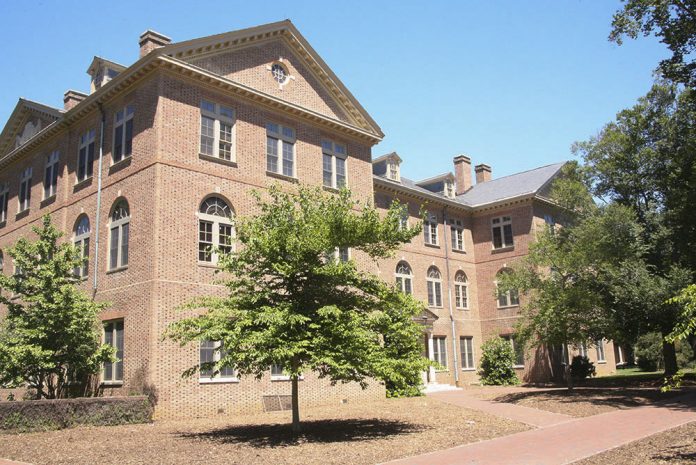Thursday, Oct. 31, Japanese studies majors, professors and students gathered in James Blair Hall to listen to University of Hawaii professor Mire Koikari’s lecture, entitled “Gender, Culture, and Disaster in Post-3.11 Japan: Mobilizing Hula Girls for National Recovery and Reconstruction.” This event focused on the cultural aftermath of the 2011 Tohoku earthquake and tsunami, which is commonly referred to as 3.11 in Japan.
Hosted by the Japanese studies program director Tomoyuki Sasaki, Koikari’s lecture was one of the inaugural events in the series celebrating the new Japanese studies major which officially began this semester.
The Japanese studies department partnered with the Wendy and Emery Reves Center for International Studies, the Asian and Middle Eastern studies program and the gender, sexuality and women’s studies program in hosting the event.
“Surprisingly, this post-3.11 disaster culture of Japan mobilizes hula girls as the leading symbol of national recovery and rebuilding,” Koikari said.
“Surprisingly, this post-3.11 disaster culture of Japan mobilizes hula girls as the leading symbol of national recovery and rebuilding,” Koikari said. “Against the backdrop of precarity, a move towards Japanese refortification proceeds, defining resilience building — that’s the one key term I’ll keep on coming back over and over again — resilience building as in an urgent agenda that involves any and then all Japanese.”
Koikari’s lecture centered around the rise of militarism, neoliberalism and nationalism in Japan since 2011, and she illustrated how Hawaii and hula girls came to embody these dynamics. In the wake of the idea of “self-help” over government aid, Koikari explained how corporations mobilize hula girls to promote spiritual healing and recovery through their dancing. Through the creation of Hawaiian-themed spa resorts and dancing tours of hula girls across the nation, Japanese culture has come to glorify the healing nature of Hawaii as well as promote off-shore tourism to the American state.
“By focusing on the deployment of Hawaii as an imagined, as well as real, space, in this post-disaster cultural mobilization, the exotic figures of dancing maidens and the famous healing powers of this ‘paradise on earth’ have articulated, but at the same time obscured, this new culture,” Koikari said. “It allows us in Japan to indulge in the dream of recuperation and in being healed, but then at the same time, avoid the question of power.”
Working in the University of Hawaii’s department of women’s studies, Koikari’s research focuses on the meaning and consequences of feminism, disaster-preparedness and security culture in modern Japan.
In the center stage of her research, Koikari cites that Japanese pop culture’s portrayal of hula girls have allowed these exotic dancers to become the symbol of resilience and self-help.
Most people in attendance were Japanese studies majors, such as Margot Baden ’20, or students who were considering coursework in the discipline.
Baden, who declared her major earlier this semester, came to Koikari’s lecture in order to show support for the Japanese studies department.
“The most interesting part was definitely the feminization of the healing movement,” Baden said. “I don’t think that it would’ve been as successful if it wasn’t something female-related that sort of had this healing effect on Japanese culture. I think she brought up a bunch of interesting issues on gender that I think have a lot of relevance to Japanese society.”
Koikari’s research also focuses on the male aspect of self-help and the role men have as the corporate actors in post-disaster Japan.
Due to the combination of the Japanese asset price bubble burst and the destructive 2011 disasters, Japan’s shifting economy has contributed to the mobilization of hula girls and Hawaii, as businessmen use their popularity for profit.
Campbell Wharton ’21, who intends to declare a Japanese studies major later this week, attended Koikari’s lecture in order to further his own knowledge of contemporary Japan.
“I think getting a lot of the history of the hula dance group was extremely interesting, especially coming from sort of an entrepreneurial side, because there was sort of this cooperate advantageous mission going on,” Wharton said.
“I think getting a lot of the history of the hula dance group was extremely interesting, especially coming from sort of an entrepreneurial side, because there was sort of this cooperate advantageous mission going on,” Wharton said.
Koikari concluded her lecture with audience questions and then urged the students to come to Hawaii to conduct their own research on Japanese culture.
“I think this healing thing is kind of a smoke screen in so many ways,” Koikari said. “Why people accept self-help … I think disaster and its aftermath really becomes an effective cultural mechanism to institutionalize the notion that the government will roll back and have limited responsibilities, and it is okay.”

